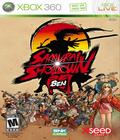Samurai Shodown is one of the great classics of fighting. A hallmark of SNK, the series may never be categorized as one of the best fighters ever, but it has always played fast and decided rounds faster, a tradition that continues onto the Xbox 360 and into the third dimension with Samurai Shodown: Edge of Destiny, now coming to the Xbox 360 in the U.S. thanks to Ignition Entertainment.
The core elements of the series are still mostly here. Fighters use weapons with heavy pseudohistorical themes, and the rage gauge, which is now controllable (you have to explicitly trigger it by pushing three buttons), still drains from full once it's been activated. There's still a fair amount of emphasis on the air game, four buttons provide everything you need, and, of course, Nakoruru is still cute.
What has changed, however, may be even more significant. The four buttons of combat now handle a little more similarly to a Soul Calibur release, with simple-to-execute special moves and a heavier focus on attack variety and how it affects timing. The air game remains very present, even though you can also run in full 3-D; the game makes it easy to play more in 2-D with the d-pad and 3-D with the analog stick, so you're encouraged to use both during play. I found the sense of timing to be a tad loose because large attacks are often too easily countered unless landed with precise timing.
The graphical style has both changed and stayed the same. It's still very anime styled, but with an interface that is more stylized in the traditions of Japanese painting. The characters are now drawn with extra attention to detail, such as the removal of flat shading and the inclusion of some grainy detail that produces a very nice effect. Fortunately, the sounds have changed, and the new set really is an improvement.
Edge of Destiny boasts 24 characters, with 13 returning from previous iterations of the series, and a good array of stages. I didn't get a chance to check if the stages are significantly interactive, but they sure looked pretty. If nothing else, SNK has some excellent graphics to showcase with this title.
Samurai Shodown: Edge of Destiny has worthy graphics and an authentic sense of the series' long-standing style, all tastefully updated to 3-D. It simply looks right.
More articles about Samurai Shodown Sen











 Samurai Shodown Sen is the 11th game in SNK's classic Japanese weapons-based fighting series and the fourth in the 3D series. The game takes place in Japan during the twilight of the turbulent Edo period, and promises to be the most brutal and visceral chapter in the Samurai Shodown series' history.
Samurai Shodown Sen is the 11th game in SNK's classic Japanese weapons-based fighting series and the fourth in the 3D series. The game takes place in Japan during the twilight of the turbulent Edo period, and promises to be the most brutal and visceral chapter in the Samurai Shodown series' history.


